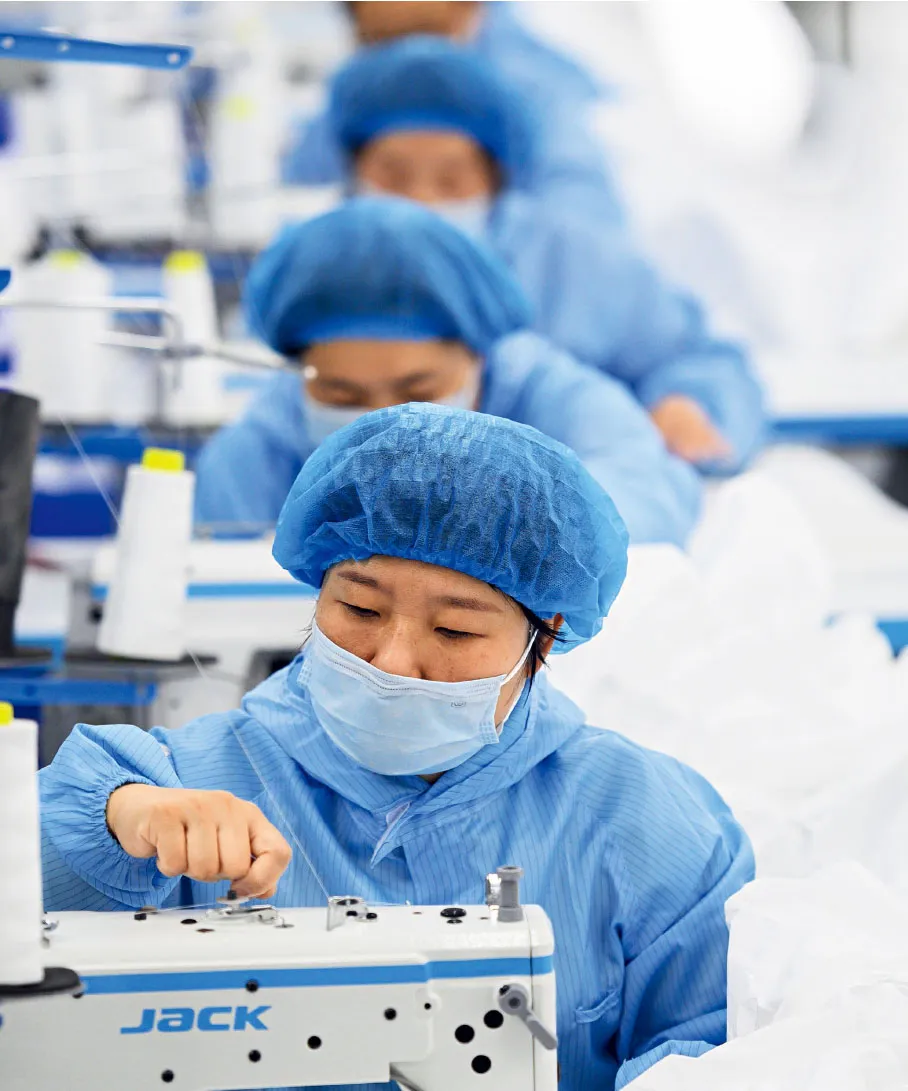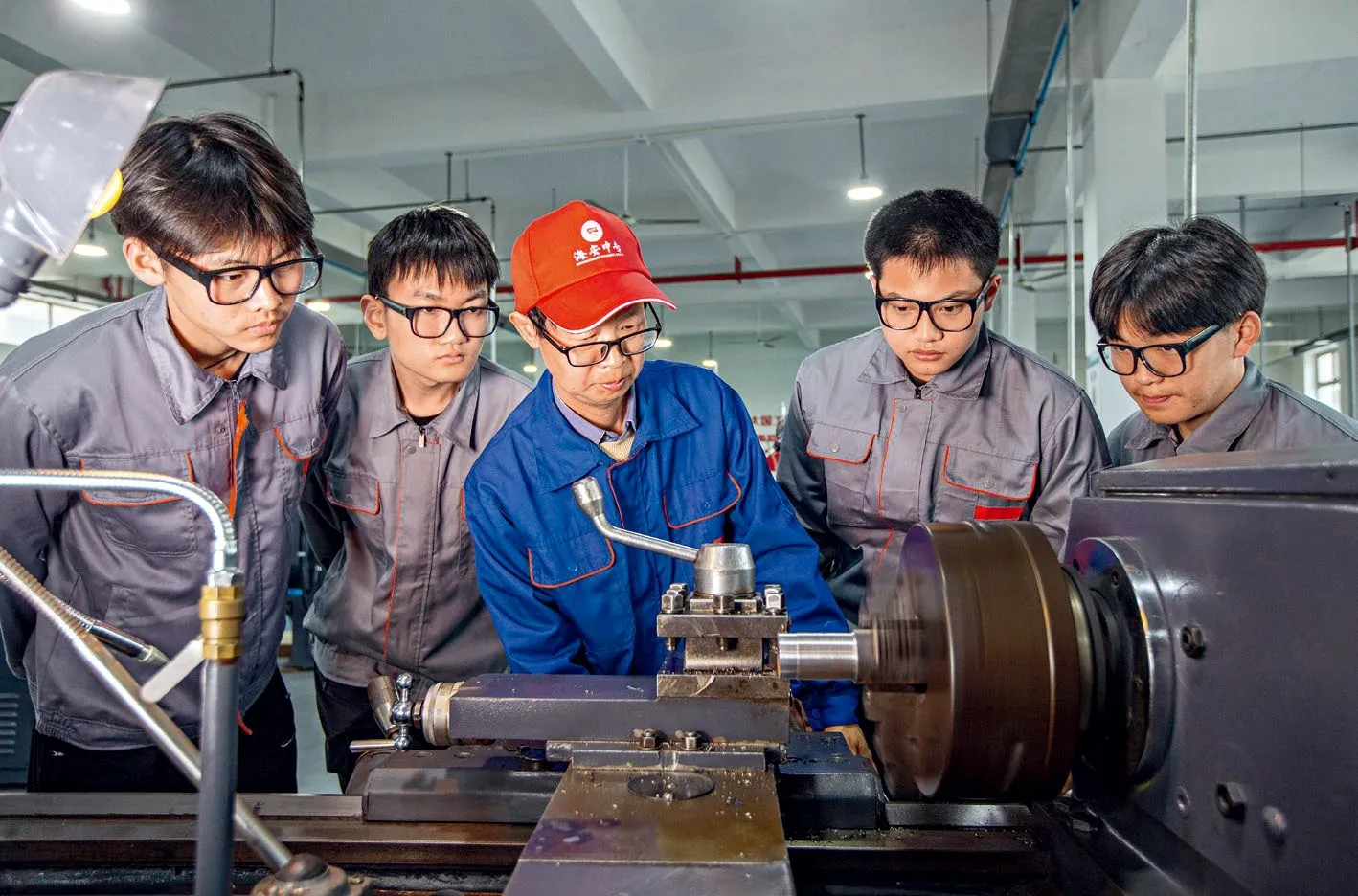Labor Shortages In Manufacturing
2022-07-20ByChenKe
By Chen Ke
As new businesses in the service industry change drastically,factory jobs are becoming the last resort for young adults

Workers sew disposable medical protective suits in a workshop of Shanxi Hong’an Technology Co.,Ltd.on April 20,2022.(WEI LIANG)
In 1991,the 10-episode television seriesWomen Migrant Workerswas broadcast on China Central Television to great acclaim throughout the country.The realistic TV program aired during a period when reform and opening-up was first implemented in Guangdong Province,and industries such as textiles,clothing,and toy-making grew into central drivers of economic development.The TV series followed six women who,like many migrant workers rushing to Guangdong to make a fortune,left home in northern China to join the huge labor market in the south,helping bring vitality to China’s economy.
After over three decades of rapid development,China now has the world’s most complete manufacturing industry.However,the less-skilled labor force is no longer in such high demand due to improved manufacturing technology.The industry is facing the dilemma of a labor supply unable to support the need for further segmentation and industrial upgrading.
Labor shortages have become even more pressing because of the current economic situation,the COVID-19 pandemic,and fluctuations of prices of raw materials.Inadequate labor supply not only hampers manufacturing companies’ production and operation,but hinders the high-quality industrial development in China.
Young Hearts
According to a recently released document summarizing the employment situation in 21 prefecture level cities in Guangdong Province,the most needed workers are general workers,technical workers,and managers,and some companies face a shortage of workers up to 640.The document lists the types,vacancies,and salaries of jobs offered by 131 companies in Guangdong Province including Chen Mo’s employer.That company is located in Zhuhai City and mainly produces aluminum alloy die casting.Their products are sold in China as well as being exported to Europe and America.
Chen is responsible for the company’s recruitment and the mission of hiring 500 workers set at the beginning of the year has stressed him out.“I have hired over 250 people since February,but more than 50 left within a week,”he revealed.“Another 50 left the company in the second month,and plus the workers we let go,we only gained about 100 workers in a couple of months.”Like many of his peers,Chen has come to terms with the bleak employment situation.
Few young people want to work at the company,and Chen,born in the 1970s,doesn’t blame them.In his opinion,many jobs in the manufacturing industry are not socially respectable,as the work is labor-intensive,low paid,and hardly esteemed by society.
“The majority of workers in my company are over 40,”he said.“We produce die castings,and the work such as smelting,metal-cutting,segregation and blanking are arduous and tedious,so older people tend to be more willing to endure the hardship.Younger workers,in comparison,do not want to work in factories like their parents did.”The young people who do work in factories usually consider it a temporary job rather than a career.
Chen said that at his company,resignations peak in the second week,the second month,and the second year after the workers are hired.“Turnover is highest after the second week and second month,and those who leave in the second year have usually gained enough experience to find a better job,”explained Chen.
Indeed,when new businesses in the service industry undergo rapid development,the definition of a“decent”job changes correspondingly.Factory work has become the last option for young job seekers.
Experts found that young graduates tend to work in service industries such as communication,internet technology,and finance.Many jobs are generated by emerging businesses such as ride-hailing drivers and parcel and food couriers.These jobs are characterized with low barriers to entry,flexibility,and relatively solid income.Such work is also pulling the young workforce away from manufacturing companies.
According to Meituan,a food delivery service provider,during the COVID-19 pandemic in 2020,the number of food couriers working for Meituan and Ele.me,another online fooddelivery platform,increased by over 2 million,and 40 percent were previously manufacturing workers.
Since last year,Chen’s company has been improving employee benefits as part of efforts to attract and retain workers.It increased employees’ food subsidies,refined the dining environment,and started honoring outstanding workers and organizing birthday dinners.Chen considers the firm’s position fortunate because although labor costs and the price of metal materials have increased while customers are demanding lower prices of products,the company is still not laying off any staff or cutting salaries.Chen imagines the situation is likely much gloomier for manufacturing companies not doing as well.
据悉,长沙家庭服务诚信平台包括“长沙家政”诚信平台网站及微信公众号“家服云”,覆盖长沙市家庭服务业协会上的千家家庭服务公司、涵盖20多万家庭服务人员的信息。在该平台上,能够查询到家政公司、家政服务员的诚信记录。凡有过不良记录的家政服务员将被列入“黑名单”,并通过平台在各家政公司共享信息。此外,通过该平台,家政公司、家政服务员和雇主还可实现“三方互评”,保证服务质量。“这为推动家政行业发展产业化、服务管理规范化、市场运营信息化、从业人员职业化迈出了坚实的一步。”长沙市家庭服务业协会会长匡力平表示。
While increasing salaries is considered the simplest way to keep more staff,ensuring the company’s survival is usually the central goal these days.
Zhou Dewen,deputy director of the Central Economic Committee of the China Association for Promoting Democracy and director of Wenzhou SME Development Association,has studied the private economy for four decades.He noted that for labor-intensive industries including manufacturing and the service industry,increasing salaries is temporarily effective to mitigate labor shortages,but the profit margins in such industries are so thin that navigating the ongoing pandemic to ensure companies’ survival is more critical than increasing pay.
A Structural Problem
Calculating precisely how many workers are needed is difficult,but research on 90,000 industrial firms each with annual main business revenue of at least 20 million yuan(US$2.97million) shined light on the labor shortage.Last April,a representative from the National Bureau of Statistics said that,according to research,around 44 percent of surveyed companies said their biggest difficulty is hiring workers.That number is the highest it has ever been.
TheCatalogue of Work in Urgent Need for Talents in the Guangdong-Hong Kong-Macao Greater Bay Area (Mainland)(2020)showed that the manufacturing industry has greatest demand for labor,with the number of workers it needs exceeding half of the total (61.93 percent).
Why is the labor shortage that used to happen seasonally and temporarily now affecting small and medium-sized enterprises more frequently? Zhou said that one reason is that domestic and global economic changes as well as the pandemic have increased employment uncertainty.Volume of orders is affected by such changes,while companies’ operating costs do not decrease when they have no orders or stop production.To reduce costs,companies have to make adjustments when hiring and laying off workers,making jobs less“guaranteed.”And given the increased costs in pandemic prevention measures and transportation,people are becoming less motivated to look for jobs.

Workers assemble heavy trucks in a plant operated by Shaanxi Automobile Holding Group Co.,Ltd.on May 24,2022.(LI YIBO)

An instructor demonstrates lathe operation to students at Hai’an Technical Secondary School in Nantong,Jiangsu Province,on May 13,2022.(VCG)
Another problem is that the labor market is in urgent need of both general workers and technical workers.According to a list of jobs with greater demand than supply (in the first quarter of 2022) released by the Ministry of Human Resources and Social Security,of the 100 types of jobs,36 were in manufacturing and 24 were for professional and technical staff.
The aforementioned employment information document of Guangdong also showed that many companies have high demands for technical qualification of workers.Some hire only technical workers,offering an average salary of over 10,000 yuan(about US$1,500),two to three times that of general workers.
“For example,we need people to adjust calibration and examine the quality of composite materials,and such work must be done by technicians,”said Chen,adding that at although his company is not short of technicians at present,with a proportion exceeding 20 percent,they are permanently recruiting technical workers.
“China has entered a stage of high quality development,meaning that traditional manufacturing businesses are undergoing transformation and upgrading while new manufacturing businesses are emerging and developing rapidly,”Zhou said.“Against a backdrop of digital technology and the manufacturing technology becoming deeply integrated,companies have higher and more specific requirements for qualifications of employees.The industry is upgraded before the labor system has a chance to catch up.”
Zhou identified two structural conflicts affecting the labor shortage.
First,the education and training system took shape during a stage of extensive development and needs to be upgraded to meet the needs of highquality development.China is still making explorations in this regard.
Second,the labor evaluation system highly recognizes highly-educated white-collar workers,which may discourage dedicated and skilled blue-collar workers from joining the manufacturing industry.The broader evaluation system also needs overall adjustment.
Upgrading Vocational Education
Vocational education is of crucial importance to China.The country needs to build a great talent pool of technical workers to become a major country with strong manufacturing prowess.
Graduation season is usually Chen’s prime time to hire workers,but not so much during the COVID-19 pandemic.Four vocational schools he contacted in early May now refuse to let recruiters come on campus and require all hiring and interviewing to be done online.
“Compared with face-to-face communication,online recruitment has many disadvantages,”Chen said.“We cannot answer many of the students’ questions,and interviews overlap because so many recruiters are using the same online platform.It makes choosing a job more difficult for the graduates.”
He recalled that last year,teachers responsible for employment gathered qualified students from over 100 majors in a big classroom so that many companies could introduce their enterprises and job openings directly.
“Basically,these companies received resumes from around 80 percent of participating students,and at least 40 percent showed intention to work at these companies.”Chen noted that vocational schools have always provided a steady supply of labor and tend to have an exceptionally high employment rate.
Zhou Jianqi has proposed rolling out short-term supportive policies to encourage more people to work in manufacturing.In the long term,Zhou said that China needs to reform its training and employment evaluation systems and promote institutional reform of relevant laws and regulations.“Reforms are an essential piece of improving the business environment of manufacturing,”he noted.
The newly revisedVocational Education Lawofficially entered into force on May 1,2022.It was the first revision of the law since it was adopted 26 years ago,and the one highlight is the legal stipulation that“vocational education is as important as general education.”
Chu Zhaohui,a researcher at the National Institute of Education Sciences,began studying vocational education in 1985.He admitted that although the scale of China’s vocational education has expanded impressively,interaction between vocational schools and labor markets is still“not good enough from an overall perspective”because administrative authorities impose too many limits on vocational education.
For example,vocational schools need the approval of administrative departments to set majors,making it difficult for the schools to target the specific requirements of the labor market by directly arranging corresponding majors.Thus,students’techniques and skills do not necessarily meet workforce requirements which are becoming more fluid,diverse,and specific.
“Many high-caliber talents are not highly skilled the moment they graduate,”Chu explained.“They need time as well as a lot of practice and experience to become proficient.”The employment rate of vocational students is relatively high,but the employment quality is generally low.Therefore,it is normal for them to change jobs frequently after graduation.“It is impossible for students to grow into professional and proficient technicians if they do not stay at one job for a long time.”
Chu noted that schools and companies are two completely different types of organizations involved in the integration of vocational education with industry.To facilitate cooperation between the two,China should either reform the education system and mechanism of vocational schools or allow schools to fully integrate into the market.
Chu also stressed not to expect too much from vocational education in terms of tackling the labor shortage because“the source dynamic of employment is high demand for labor,which fundamentally relies on the healthy development of industry.”
猜你喜欢
杂志排行
China Report Asean的其它文章
- Pause…And Play
- Mutual Prosperity China and its Southeast Asian neighbors need to enhance industrial cooperation
- Indo-Pacific Economic Framework:A New Landscape?
- INDIA-CHINA TIES SHOULDN’T BE HELD HOSTAGE TO QUAD
- SHANGRI-LA DIALOGUE:ASEAN’S REAFFIRMED OUTLOOK ON THE ASIA-PACIFIC
- NEW OPPORTUNITIES FOR HONG KONG-ASEAN TRADE
